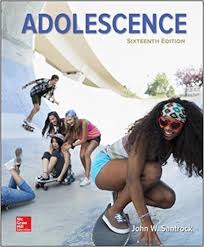Description
Santrock Adolescence 16Th Edition By John W Santrock – Test Bank
Chapter 03
The Brain and Cognitive Development
1. The basic units of the nervous system are
A. synapses.
B. neurons.
C. neuronal matrixes.
D. neurofibrillary plaques.
2. Which of the following is NOT a basic part of a neuron?
A. dendrite(s)
B. axon
C. cell body
D. synapse
3. What is the main difference between a myelinated cell process and a cell process without myelin?
A. Myelinated cell processes are more efficient at information processing than non myelinated cell processes.
B. Myelinated cell processes are slower at information processing than non myelinated cell processes.
C. Non myelinated cell processes are faster at information processing than myelinated cell processes.
D. There is no difference between myelinated and non myelinated cell processes.
4. Which of the following statements about synaptogenesis is NOT true?
A. Synaptogenesis begins in infancy.
B. Synaptogenesis continues in adolescence.
C. Synaptogenesis ends in late childhood.
D. Synaptogenesis is the process of building connections between neurons.
5. Increases in levels of dopamine can do which of the following?
A. increase risk of onset of schizophrenia
B. increase risk-taking behavior
C. increase risk of use of addictive drugs
D. All of these choices are correct
6. The bundle of axon fibers that connect the two hemispheres of the brain is called the
A. corpus callosum.
B. prefrontal cortex.
C. hippocampus.
D. amygdala.
7. Which of the following statements regarding the corpus callosum is NOT true?
A. It is a large bundle of axon fibers.
B. It becomes smaller in adolescence.
C. Its change in adolescence improves the ability to process information.
D. All of these are false.
8. The prefrontal cortex is primarily involved with
A. reasoning.
B. processing emotions, such as love.
C. emotional regulation.
D. All of these choices are correct.
9. Which of the following statements regarding the amygdala is TRUE?
A. It is the seat of emotions.
B. It is part of the limbic system.
C. It matures much earlier than the prefrontal cortex.
D. All of these choices are correct.
10. Lisa, age 18, finds that she cannot control her emotions when she becomes angry. She lashes out at those around her in an inappropriate way. Nelson and colleagues would say that Lisa’s _____ is not able to handle the emotional intensity of her _____.
A. amygdala; prefrontal cortex
B. prefrontal cortex; amygdala
C. median forebrain bundle; cerebellum
D. pons; amygdala
11. Which of the following statements regarding neurogenesis is NOT true?
A. People can generate new brain cells throughout their lives.
B. Researchers have documented neurogenesis in the hippocampus.
C. Drugs, stress, and exercise may affect neurogenesis.
D. Researchers have documented neurogenesis in the prefrontal cortex.
12. Stan tells you that he sustained a head injury as the result of a car accident. He has since lost his sense of smell. Stan’s accident likely damaged his
A. olfactory bulb.
B. amygdala.
C. occipital lobe.
D. association area.
13. Julie suffered a stroke in the area of her hippocampus. Which of the following difficulties would you expect Julie to experience?
A. difficulty in maintaining her balance
B. problems with her memory
C. problems with night vision
D. loss of her sense of touch
14. Increasing age interferes with the brain’s ability to recover from injury because
A. the brain repairs itself best in childhood and adolescence.
B. brain plasticity disappears entirely by emerging adulthood.
C. brain plasticity is best in middle age.
D. None of these choices are correct.
15. According to Piaget, adolescents are motivated to understand their world because doing so
A. makes them look “cool” to their friends.
B. makes them look grown up to their parents.
C. is biologically adaptive.
D. is necessary for making friends and starting romances.
16. Adolescents _____ their experiences to help them _____ their cognitive worlds.
A. organize; passively construct
B. passive construct; adapt
C. adapt; assimilate
D. organize; actively construct
17. Piaget proposed that children and adolescents use and adopt their schemas through the processes of _____ and accommodation.
A. adaptation
B. analysis
C. assimilation
D. application

Reviews
There are no reviews yet.